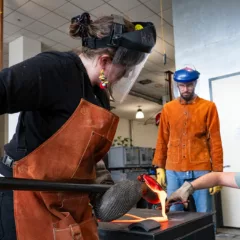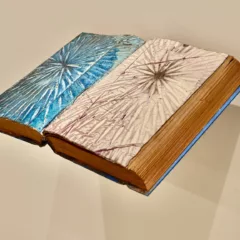Post-Apologetic spotlights the aesthetically complementary work of four accomplished artists, each with ties to Philadelphia: Leeza Meksin, Rebecca Saylor Sack, Paul DeMuro and Kati Gegenheimer.
Leeza Meksin’s bold, exotic, provocative creations
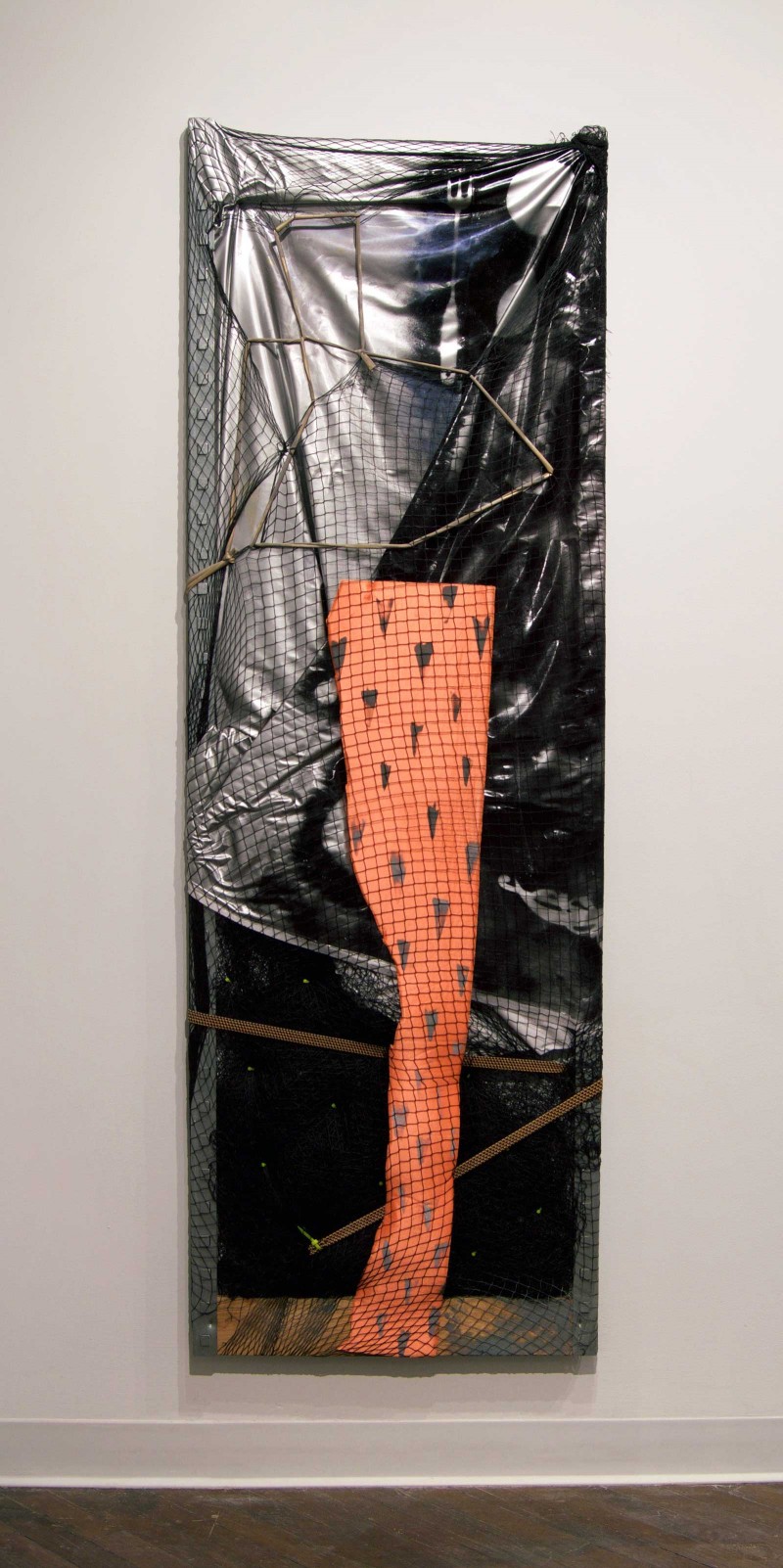
Leeza Meksin, 38, is a Brooklyn-based interdisciplinary artist who explores polarities in her work and whose subjects have been influenced by her experience of emigration from Russia to the United States. She is known for her “colorful, feminine, racy costumes for walls, balconies, interiors,” and, wonderfully, she has also dressed the exterior of buildings in spandex.
Meksin’s “Night Door,” pictured here, is made of fishing net, zip ties, neoprene, spray paint, and oil on a wood and steel frame. In her other three pieces in this show, we find a grab bag of recycled, zany materials, some of which we may be less than proud of, or even troubled by, including spandex, athletic mesh, ratchet strap, nylon, pillow, hair net, light reflective fabric, and upholstery tacks. It’s hard not to gravitate to Meksin’s work. It is idiosyncratic, bold, provocative, and challenging.
Meksin received an MFA from Yale School of Art, a BFA from The School of the Art Institute of Chicago, and a joint BA/MA in Comparative Literature from the University of Chicago. She taught at Tyler from 2007-2011, currently teaches at Columbia, and is a member of Ortega y Gasset Projects, an artist-run curatorial collective and exhibition space in Gowanus, Brooklyn.
Rebecca Saylor Sack’s wonderfully intense, disturbing paintings
Rebecca Saylor Sack has two paintings in Post-Apologetic, including the untitled painting (known as “deer, horse”), pictured here.
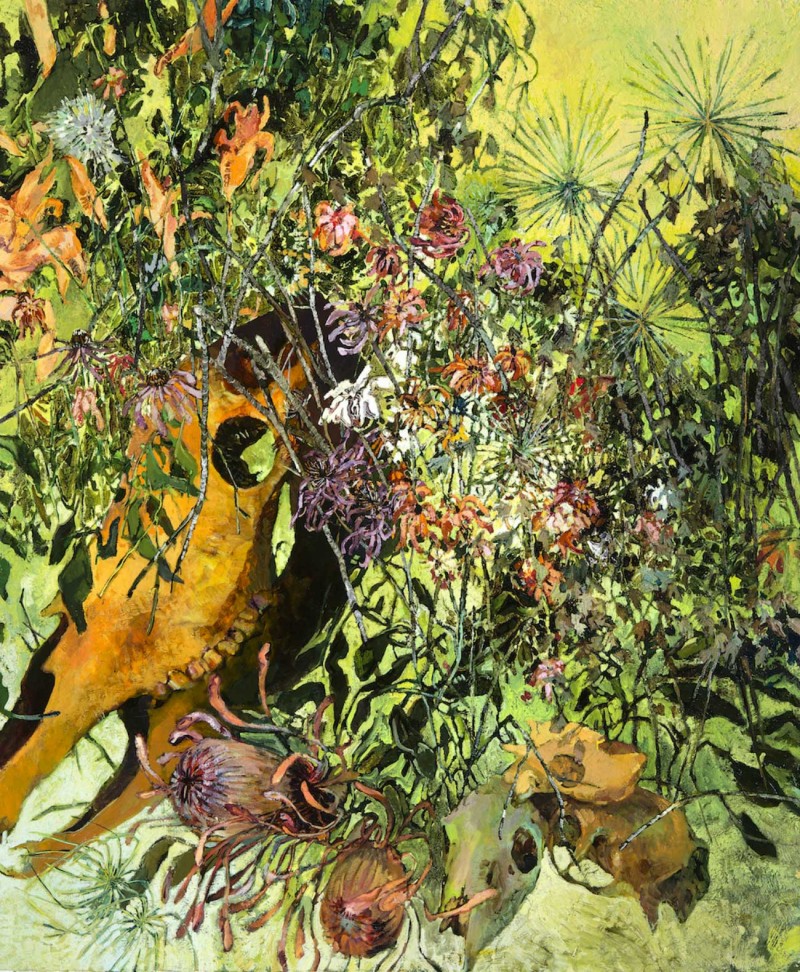
Sack’s painterly work is dense and can be disturbing. The intense floral scene in “deer, horse,” for instance, integrates a perforated animal skull, incisors and all. Indeed, a number of the flowers themselves are somewhat insidious. Unsurprisingly, she states: “My paintings are inspired by the tradition of the vanitas still life, and draw from narratives of speculative fantasy and science fiction.” The artist is splendid with color and accomplished, like Meskin, in mining the polarities of “stability and riot, growth and decay.”
Sack earned her MFA from Tyler School of Art and her BFA from the Cooper Union. She is a recipient of the Fleisher Wind Challenge, and currently teaches painting at the University of the Arts, where she is the new Interim Program Director of the Interdisciplinary Fine Arts Program. She has exhibited widely, including shows here in Philadelphia at the Seraphin and Rosenfeld galleries. Her 2012 show at Seraphin, Albatross, was reviewed by Alison McMenamin for Artblog.
Paul DeMuro explores the boundaries of man and machine
Paul DeMuro, a 34-year old Tyler grad out of Philadelphia, has two paintings in Post-Apologetic. In his biography, DeMuro makes the curious point of noting that he was raised Catholic and grew up in a row house near four different cemeteries.
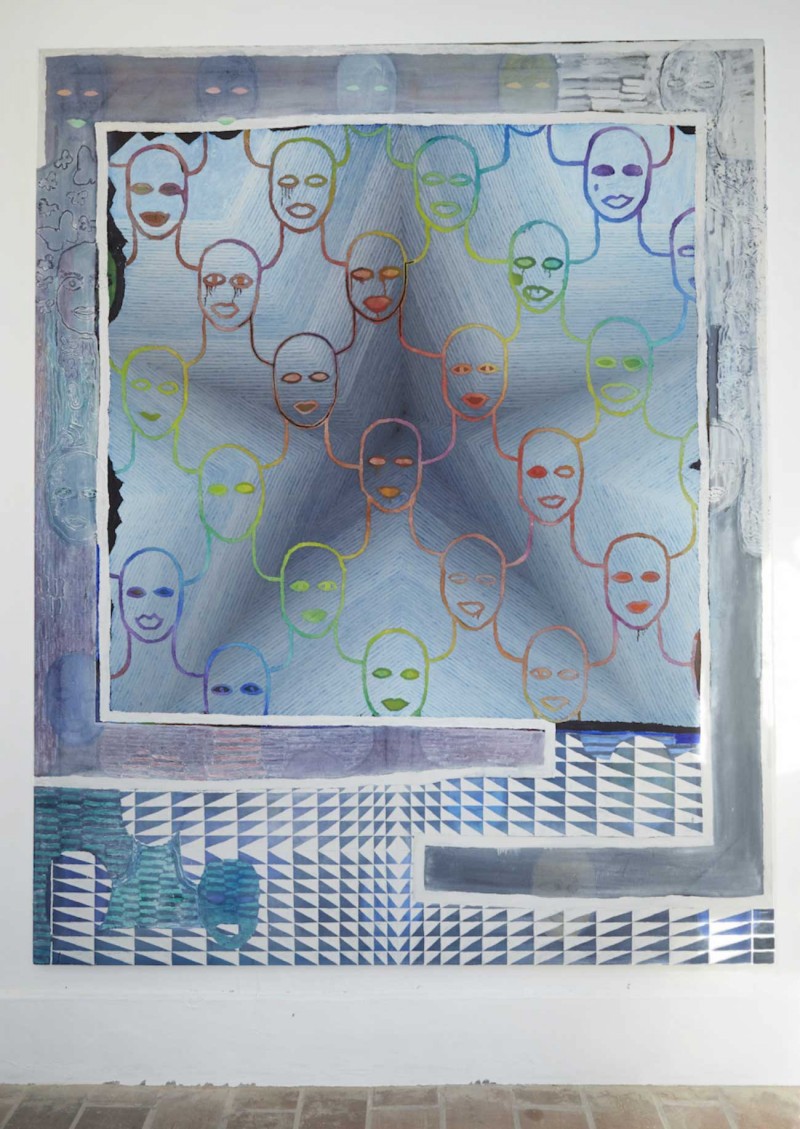
DeMuro’s large oil painting, “Crowd-Faces,” featured here, dominates the gallery. The artist is known to paint images as they appear on computer screens and to explore the boundaries of man and machine, and in this piece there are interconnected outlines of heads and torsos superimposed on a multi-leveled, five-point star (which I don’t quite know what to make of), all on a thickly painted screen. Some of the figures, none of which have ears or noses, appear to be tearful, and those on the perimeter of the screen breach it and bleed into the negative space along the edges of the canvas.
The day is long past when we could take for granted our screen lives and pretend that we are somehow separate from those lives. The etherized connections between DeMuro’s disembodied souls evoke the degree of alienation which our machine-driven culture may generate. The painting also makes a statement about the tendency of that culture to stifle individuation. In any event, DeMuro suggests that it is a long journey from our screen lives to meaningful connections with other human beings. There is much for his figures to be tearful about.
For a very interesting contrast to this work, see Hiroshi Sugimoto’s amazing “Sea of Buddha” photographs of the thousand (interconnected) bodhisattvas in Kyoto, which will be on display at the Pace Gallery in New York next month.
DeMuro received his MFA in Painting from Rutgers University in 2010. He has exhibited extensively, including a 2011 show, Bleach, a two-person show with Alex Da Corte at Jolie Laide in Philadelphia. A review of that show by Chip Schwartz appeared in Artblog as well.
The delightful drawings of Kati Gegenheimer
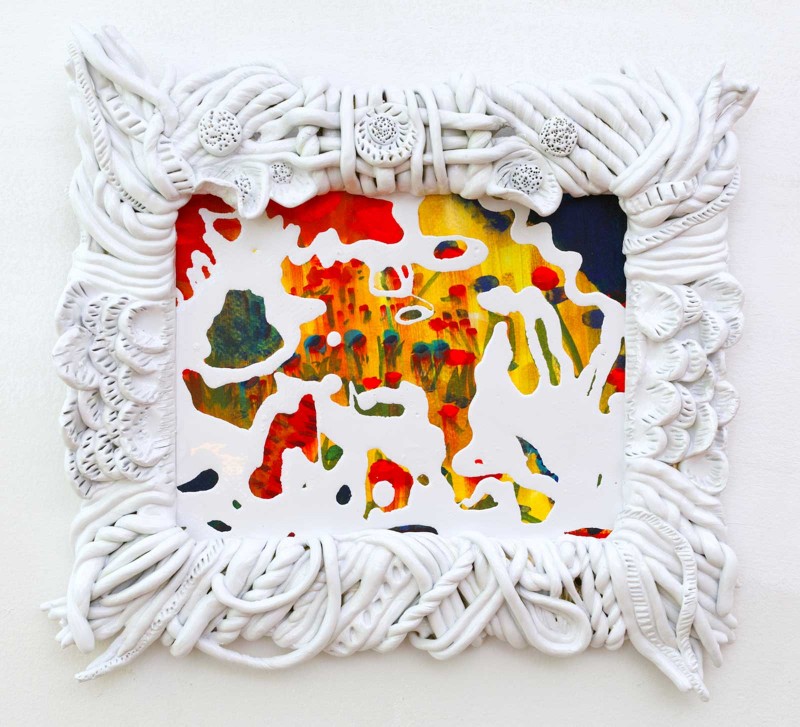
Kati Gegenheimer, 32, has seven pieces in the exhibition, including “Gift Drawing For Odilon Redon,” pictured here. They are a series of small, bright, colorful, abstract drawings. Each of them is composed with acrylic and enamel on paper, and they shine with the enamel and indeed appear as if they are painted upon a glossy hard white surface. They are cheerful, decorative, and appealing. The drawings, however, are eclipsed by the elaborate white frames Gegenheimer created for them, which are distracting and too serpentine for my taste.
Gegenheimer is a printmaking graduate of Tyler School of Art (2007), and she received her MFA from Yale in painting and printmaking (2013). She currently lives in Bushwick. In 2013, she founded StaringAtTheWall.com, an art blog for artists by artists, and appeared in a 2015 interview in Maake Magazine.
The imponderable title of the show
A word about the curious, imponderable title of the show. I certainly did not find anything about the exhibition that called for an apology, or to be unapologetic about. Nor is there any discernable post-apologetic glow, relief, or remorse. When I asked the curators about their vision for the exhibition, they spoke about moving beyond and pushing through clichés (without apology); they spoke about excess; they spoke about being unafraid to approach the ugly or the uncomfortable; they spoke about reconsidering what may be viewed as “flamboyant, wasteful, or trite”.
At the end of the day I have some questions about the coherence of what the curators were seeking to accomplish by putting the work of these four artists together. That said, in their own and in very different ways, the works of Meksin, Sack, and DeMuro are introspective, thought-provoking, and push against some of the boundaries that the curators sought to explore. However, I thought that Kati Gegenheimer’s drawings, although pleasing in their own right, did not fit in. Still, overall, the pieces in the exhibition really do complement each other, and they are skillfully presented in the gallery. You may find Post-Apologetic to invoke a rollercoaster of thoughts and emotions, a worthy goal for any exhibition.
AUTOMAT is a curatorial collective composed of seven PAFA graduates, which opened in April of 2015. It is located in the same building as Vox Populi, Savery, Napoleon, and Marginal Utility, on North 11th Street. Members Morgan Hobbs and Rebecca Sedehi curated Post-Apologetic. The remaining members of the collective are Nadine Beauharnois, Emily Elliott, Jillian Schley, Shane Smith, and Tiffany Tate. Post-Apologetic will be on display at the gallery through February 19, 2016.



